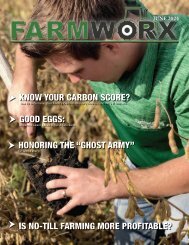July 2023 issue of the Farmworx Magazine
Free agricultural geared magazine published by Dudley Printing, Rockwell City, Iowa
Free agricultural geared magazine published by Dudley Printing, Rockwell City, Iowa
Create successful ePaper yourself
Turn your PDF publications into a flip-book with our unique Google optimized e-Paper software.
<strong>July</strong> <strong>2023</strong><br />
First-generation farmer James Hepp<br />
ed to soybeans <strong>the</strong> next spring. It’s<br />
more difficult to screw that up,” said<br />
Hepp, whose goal is to have all <strong>of</strong> his<br />
soybean acres in cover crops.<br />
2. Try different seeding options.<br />
Late summer (mid-August to early<br />
September) is an ideal time to seed<br />
cover crops. “When we’ve seeded<br />
cover crops into standing corn at<br />
that time, I’ve had 3-inch-tall rye going<br />
into harvest,” Hepp said. “Running<br />
<strong>the</strong> combine over that is nice,<br />
because it’s like driving on turf.” To<br />
seed his cover crops, Hepp has used<br />
aerial seeding from an airplane to<br />
hiring a local farmer with vertical tillage<br />
equipment. Hepp is looking into<br />
drone technology for seeding clover<br />
and o<strong>the</strong>r cover crops. He also has<br />
an air seeder he can put on his Hagie<br />
high-clearance applicator and is<br />
studying <strong>the</strong> best way to make this<br />
work.<br />
3. Test your results. In late May<br />
<strong>2023</strong>, Hepp clipped a 3-foot by<br />
3-foot sample <strong>of</strong> his rye cover crop<br />
and sent <strong>the</strong> sample to Regen Ag<br />
Lab in Pleasanton, Nebraska. (Regen<br />
Ag Lab provides accurate, reliable<br />
testing services surrounding<br />
<strong>the</strong> principles <strong>of</strong> soil health and regenerative<br />
agriculture.) The results<br />
shocked Hepp. “Along with 2.2 tons<br />
<strong>of</strong> dry matter, <strong>the</strong> sample showed<br />
110 pounds <strong>of</strong> potassium and 22<br />
pounds <strong>of</strong> phosphorus,” said Hepp,<br />
who noted that’s enough potassium<br />
to produce 85-bushel-per-acre soybeans.<br />
“This wasn’t even my best rye<br />
cover crop, but <strong>the</strong> tests showed <strong>the</strong><br />
rye has scavenged a lot <strong>of</strong> nutrients.”<br />
While many <strong>of</strong> Iowa’s rich soils<br />
contain abundant nutrients, <strong>the</strong><br />
chemistry and composition <strong>of</strong> certain<br />
soils can make it tough for plants to<br />
absorb <strong>the</strong>se nutrients. Beneficial<br />
soil microbes linked with cover crops<br />
can help “unlock” this natural fertilizer.<br />
“These nutrients are in an organic<br />
form that’s like a slow-release fertilizer<br />
that feeds <strong>the</strong> crops,” Hepp said.<br />
In some cases, this can help lower<br />
<strong>the</strong> fertilizer bill, or it allows farmers<br />
to reallocate fertilizer resources for<br />
more timely, strategic applications.<br />
“I’ve cut back on dry fertilizer applications<br />
and am using more liquid, foliar<br />
feeding during <strong>the</strong> growing season,”<br />
Hepp said. “This allows me to ‘spoon<br />
feed’ my crop <strong>the</strong> nutrients it needs,<br />
when it needs <strong>the</strong>m.”<br />
Cover crops also help suppress<br />
weeds, which can help reduce herbicide<br />
applications. “I try to do only one<br />
post-emerge herbicide pass, if I can,”<br />
Hepp said. “Also, with cover crops in<br />
soybeans, I’m able to skip a residual<br />
herbicide pass and get better weed<br />
suppression, which normally pays for<br />
<strong>the</strong> cost <strong>of</strong> <strong>the</strong> cover crop.”<br />
Roughly 70 people ga<strong>the</strong>red at Hepp Farms near<br />
Rockwell City to learn about making cover crops pay.<br />
4. Set goals. Hepp can’t forget all<br />
<strong>the</strong> “snirt” (dirty snow) that covered<br />
<strong>the</strong> Iowa landscape following a blizzard<br />
right before Christmas 2022.<br />
“Seeing all that black soil in <strong>the</strong> ditches<br />
broke my heart. It also reminded<br />
me why building soil health and holding<br />
that valuable soil in place is my<br />
top goal with cover crops.”<br />
Hepp’s second goal is to increase<br />
efficiency and save time. He has reduced<br />
tillage, thanks to strip tillage<br />
and no-till, and he’s finding ways to<br />
make cover crops work with this system.<br />
Hepp’s third goal for his cover<br />
crops revolves around ROI. He plans<br />
to seed more diverse species <strong>of</strong> cover<br />
crops, since each one supports<br />
certain microbes that provide specific<br />
soil health benefits. “Clovers help <strong>the</strong><br />
microbes that play a role with nitrogen<br />
fixation,” Hepp said. “This potentially<br />
helps you lower your nitrogen<br />
fertilizer bill.” Hepp is also interested<br />
in developing an additional income<br />
stream through custom cover- crop<br />
seeding and raising rye for cover<br />
crop seed.<br />
5. Make cover crops part <strong>of</strong> your<br />
farm management plan. Now that<br />
he has experience seeding cover<br />
crops on corn acres that will be planted<br />
to soybeans, he’s experimenting<br />
with <strong>the</strong> best ways to use cover crops<br />
on soybean acres that will be planted<br />
to corn next spring. “If you’re serious<br />
about cover crops, you need to make<br />
<strong>the</strong>m part <strong>of</strong> your farm management<br />
to-do list,” Hepp said.<br />
Hepp encourages o<strong>the</strong>r farmers<br />
to take advantage <strong>of</strong> cover crop costshare<br />
opportunities through Practical<br />
Farmers <strong>of</strong> Iowa and o<strong>the</strong>r organizations.<br />
Also, seek out o<strong>the</strong>r farmers<br />
with cover-crop experience, and<br />
find online resources like XtremeAg’s<br />
Cutting <strong>the</strong> Curve podcast, he advised.<br />
“I’ve cut my learning curve this<br />
way, and I want to help o<strong>the</strong>rs learn.<br />
If you want cover crops on your acres<br />
and are willing to put some effort into<br />
this, cover crops will work for you.”<br />
Page 5

















